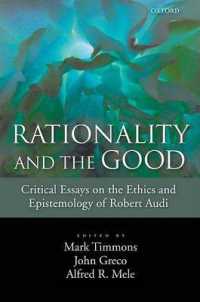Full Description
How children acquire language and literacy knowledge in many different contexts—and how teachers can effectively promote the development of oral and written language—is the focus of this highly regarded resource. Readers get an authoritative look at how children acquire language and literacy in a variety of contexts and how teachers can effectively promote development in oral and written language.
Teaching Language and Literacy integrates a constructivist/emergent literacy perspective with scientifically-based instructional practices that are successful in supporting children's reading, writing, listening and speaking development. This new edition features the work of a new author, Kathleen Roskos, and includes numerous up to date references, examples, and hands-on activities for putting theory into practice in today's classrooms.
Contents
Preface
PART ONE: FOUNDATIONS
1. Foundations of Language and Literacy
Before Reading This Chapter, Think About . . .
Focus Questions
Language and Literacy: Definitions and Interrelationships
The Common Core State Standards
A Continuum of Instructional Approaches or "The Reading Wars"
A Comprehensive Literacy Instructional Program
Summary
Linking Knowledge to Practice
2. Oral Language Development
Before Reading This Chapter, Think About . . .
Focus Questions
Language Acquisition Theories
Linguistic Vocabulary Lesson
Observing the Development of Children's Language
What Is Normal Language Development?
Factors Contributing to Variation in Rate of Language Acquisition
Family Focus: Developing Language Over Time
Summary
Linking Knowledge to Practice
3. Family Literacy
Before Reading This Chapter, Think About . . .
Focus Questions
Home Talk: A Natural Context for Learning and Using Language
Home Literacy Experiences
Family Focus: Parent Workshops
Case Studies
Summary
Linking Knowledge to Practice
4. Facilitating Oral Language Learning
Before Reading This Chapter, Think About . . .
Focus Questions
Explicit Vocabulary Instruction
Rich Classroom Language Experiences
Contexts That Encourage Language Use
Language-Centered Activities for Children
Promoting Oral Language in the Elementary Grades
Family Focus: Sharing the Fun and the Language Learning
Strategies for Teaching English Language Learners: Helping Children Develop Conversation and Academic Language Skills
Strategies for Children with Special Needs: Speech Delays
Summary
Linking Knowledge to Practice
PART TWO: EARLY LANGUAGE AND LITERACY INSTRUCTION
5. Emergent Literacy Strategies
Before Reading This Chapter, Think About . . .
Focus Questions
Print-Rich Classroom Environments
Sharing Books with Young Children
Shared Writing
Family Focus: Sharing Instructional Materials and Offering Guidance
Strategies for Teaching English Language Learners: Storybook Time
Strategies for Children with Special Needs: Reading Storybooks with Children with Disabilities
Summary
Linking Knowledge to Practice
6. Teaching Early Reading and Writing
Before Reading This Chapter, Think About . . .
Focus Questions
Early Reading Instruction
Early Writing Instruction
Family Focus: Creating a Book Nook and Author's Corner
Strategies for Teaching English Language Learners: Modifying the Classroom Environment
Strategies for Children with Special Needs: On Your Mark, Get Set, Go
Summary
Linking Knowledge to Practice
7. Assessing Early Literacy: Finding Out What Young Children Know and Can Do
Before Reading This Chapter, Think About . . .
Focus Questions
Determining What Children Know and Can Do
Ongoing Assessment
On-Demand Assessment
Using Assessment Data to Plan Early Literacy Instruction
Family Focus: Sharing Assessment Results With Parents
Strategies for Teaching ELLs: Assessing English Language Learners' Language and Literacy
Summary
Linking Knowledge to Practice
PART THREE: ELEMENTARY GRADE LITERACY INSTRUCTION
8. Beginning Reading Instruction: Helping Children Learn to Read
Before Reading This Chapter, Think About . . .
Focus Questions
Understanding the Reading Process
Overview of Beginning Reading Instruction
Elements of Beginning Reading Instruction
Strategies for Children with Special Needs
Summary
Linking Knowledge to Practice
9. Continuing Reading Instruction in Grades 3-5
Before Reading This Chapter, Think About . . .
Focus Questions
The Content of G3 — G5 Reading Instruction
Reading Development Ages 9 — 11
The Comprehension Process
Teaching Read-to-Learn Skills and Strategies
The Reading Program
The Reading Lesson
Monitoring Reading Progress
The Reading Lesson
Organizing for Reading Instruction
Strategies for Teaching English Language Learners
Summary
Linking Knowledge to Practice
10. Creating Writers: Teaching Children to Write Well
Before Reading This Chapter, Think About . . .
Focus Questions
The Essentials of Teaching Writing
Preparing the Classroom Environment
The Structure of the Teaching of Writing: The Components of Writing Workshop
Using Technology in the Teaching of Writing
The Explicit Teaching of Writing
Strategies for Teaching English Language Learners
Writing Instruction: Strategies for Children with Special Needs
Family Focus: Connecting Home and School
Summary
Linking Knowledge to Practice
11. Teaching the Mechanical Skills of Writing
Before Reading This Chapter, Think About . . .
Focus Questions
Spelling
Grammar
Capitalization and Punctuation
Handwriting
Strategies for Teaching English Language Learners
Family Focus: Helping Children With Spelling
Summary
Linking Knowledge to Practice
12. Assessment: Determining What Older Students Know and Can Do
Before Reading This Chapter, Think About . . .
Focus Questions
An Assessment System
High Stakes Assessment of Reading and Writing Achievement
Classroom —Based Assessment of Reading Performance
Assessing Students' Writing Performance
Family Focus: Explaining Tests and Test Scores to Parents
Summary
Linking Knowledge to Practice
References
Author Index
Subject Index








